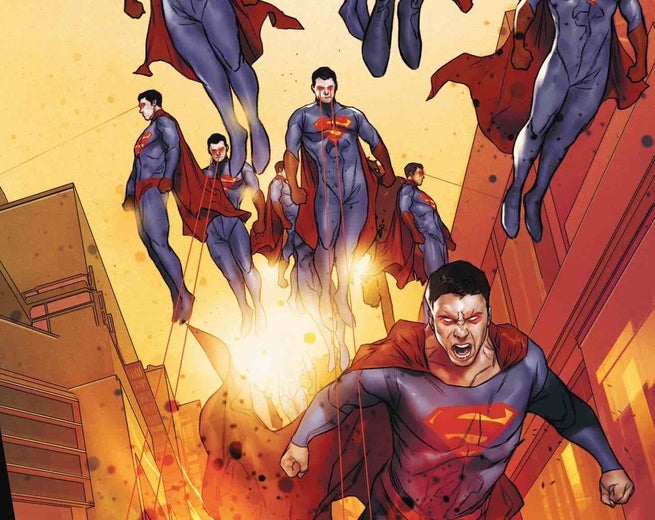
The Multiversity: Pax Americana #1 is an infinitely complex comic book composed of intricate panels and pages that function both independently and together. The comic even provides instructions within its text about how to read it, offering explanations for panel transitions and directing readers to read the issue forwards, backwards, and chronologically. At one point Captain Atom rejects a formalist reading of the issue, encouraging readers to look beyond the technical merits of the comic. Looking at his beloved dog Butch now separated into separated organs, he says, “I thought the pieces would explain the whole. But–it’s hard to love the pieces”. Pax Americana cannot be fully understood by an examination of its individual pieces; it requires a holistic assessment.
Videos by ComicBook.com
The thesis of Pax Americana is evident no matter how you read the issue. It is a story that begins and ends with events that reflect one another. Whichever way you choose to read it, the story begins and ends with a murder.

When read from front to back, that murder is the assassination of President Harley by the Peacemaker. The opening three pages play the event out in reverse moving from the burning remains of a peace flag to Harley’s ruined face to the bullet flying towards him and, finally, to Peacemaker firing it from the sky. It is a devastating sequence that does not avoid the moment of death, but watches the bullet move through Harley’s skull and explode his jaw in a mess of gore. This is really the chronological end of the story along with the interrogation and ascendency of Doctor Eden to the presidency though.
Chronologically, the story begins on its final three pages where Harley is only a child. He has snuck into his father’s studio to look at his father’s work as a comic book artist. While he is in there, Harley discovers a gun hidden in a drawer. When his father reappears dressed in the costume and mask of a superhero, Harley fires the weapon and kills him. This is the end of the comic, but the beginning of the story.

These murders mirror one another. Both scenes center on a murder committed with only the best intentions. Peacemaker acts on Harley’s order and Harley acts fearing an intruder. Both result in the death of a beloved father figure. Harley murders his actual father, while Peacemaker murders a man he implicitly trusts and loves. Together these two horrific acts create a perfect circle to contain the events of the comic.
The structure of these two sequences is the same. The first two and final two pages are presented in a perfect 4×2 grid; only the third page of the issue breaks this pattern slightly. Both murders occur in slow motion. It is possible to see the firing of the gun and the bullet itself is revealed to be locked in time in the fifteenth panel from the front and back of the issue in perfect symmetry.
There are massive changes in the scale of these murders. One is the assassination of a President, an act capable of changing the course of United States and world history. The other is a private tragedy, but one that mirrors hundreds of similar events that occur every year in the United States where over 600 people are killed each year in unintentional shootings. In Pax Americana, the scale of the murder is made to be insignificant in comparison to the impact and damage. Each event requires the same amount of space and is presented with equal gravitas and significance within this story. A boy accidentally murdering his father is revealed to be every bit as damaging as a man killing the President. Harley’s death at the beginning of the issue signals the end of the world, a death of hope and endless spiral towards fire. It begins with an accidental murder in a suburban home.
Even though the antagonist of Pax Americana is not immediately obvious, the consequences of the story are enormous. Like every issue in The Multiversity it ends (or begins) with the world ending. Here there is no Lexie Luthor like in The Just #1 or Vandal Savage like in Society of Super-Heroes #1. On the surface, Doctor Eden, Sarge Steel, and Iron Arms may seem to be the villains. They move in the background, manipulating politics and killing others. They are not the focus of the issue though. The murders that end the world are committed by Peacemaker and Harley, a superhero doing what he believes is right and an innocent child. They are not the villains of the piece, but their actions are. The act of murder, the use of violence, and the instruments used to kill are the true villain of Pax Americana and The Multiversity.

This is revelatory in that the villains of the previous issues of The Multiversity have been the same. In The Just #1 Lexie Luthor is turned against her friends and cohorts due to neglect and the corruption of the haunted comic book. She is not the person threatening the world at the end of the issue though. The real threat comes from an army of Superman robots. They are an army of weapons designed to silently watch over humanity and strike down evil doers. These drone-like robots are what bring destruction to the world of The Just.
In Society of Super-Heroes #1, it is not Vandal Savage who has invited judgement day at the end of the issue. It is the Immortal Man. In the final pages of the issue, he clearly explains that the five-year war against Counter-Earth was merely a precursor to something much worse. He brings about the worse thing by killing Savage with his first invention: a weapon. It is the act of killing and the use of a weapon that destroys the world, even when it is used to stop a hostile invasion.

Violence, weapons, the act of killing: these are the true antagonists in The Multiversity and nowhere is that more obvious than in Pax Americana. It is a story that serves to directly reject the act and tools of murder in any and all forms.
No act of violence in Pax Americana is purposeless or committed entirely for selfish motives. None of the killers obviously enjoy killing and they all believe what they do serves some greater purpose. The most obvious example of these good intentions is revealed in the assassination of President Harley. It is a murder planned by the President himself in order to save the world, every bit as much a suicide as a homicide. As a young man Harley discovers an ultimate algorithm that explains everything, capable of predicting the stock market or fashion trends. Using this knowledge he creates a plan in which he will be killed by the Peacemaker, then resurrected by Captain Atom allowing him to transform into a savior-figure and bring about world peace.
This ultimate algorithm is a farce though. Nora O’Rourke cracks the code and discovers that the plan is bound to fail, but is murdered before she can alert her husband, Peacemaker. Her murder itself comments on the futile nature of predicting the future. Her skull is crushed by a bust of the Roman god Janus whose two faces stare into the past and future simultaneously. Even with all of the knowledge in the universe available to her, Nora is incapable of changing the course of history. The characters within Pax Americana are incapable of changing their future through the use of predictive models. Readers are rendered equally powerless, presented with events in reverse order and only able to change their order. No amount of research or study is capable of altering the terrible events within these pages.

The plan is flawed at an even more fundamental level though. When Harley first approaches Atom about his plan, Atom has killed his dog Butch and resurrected him in a new body. Atom comments on the new version of Butch saying, “It’s not the same.” Even though he appears to have power over life and death, Atom knows that it is impossible to reverse his act. Murder cannot be undone and life cannot truly be restored once it is taken. These are universal constants just like gravity. Butch’s corpse still lies at the new Butch’s feet. Harley is present for Atom’s statement, but unable to truly hear it.
Algorithm 8 and all of the other fantastic tools and powers in this world are incapable of fixing death. These wonders are applied to a plan designed to bring about world peace through murder and the effort is ultimately futile. It is a utilitarian approach to the world where Harley, Peacemaker, and their comrades support the means of their mission due to its venerable goal. The murder of the President is acceptable because it is intended to bring about peace. This is the cruel joke of Pax Americana though; Harley’s plan is a farce bound to fail.
Harley intends to bring about peace through the use of violence. The Peacemaker is a fighter who uses a gun. These men and their actions contain a terrible hypocrisy. They have noble goals, but strive to achieve them with the very thing they intend to end: violence. Just like Ozymandias’ plan in Watchmen, Harley’s plan was never capable of succeeding.

Pax Americana presents violence as an infinite loop. What began with a gun ends with a gun, what began with a murder ends with a murder. The effect of killing in any form is to destroy its victim, its perpetrator, and eventually the entire world. Harley’ killing his father culminates in his own destruction fifty years later. Peacemaker’s murder of Harley destroys his own life. Together, these acts doom their world. Even world peace is not justification enough to fire a gun in Pax Americana. In this story there is never a justification to possess a gun or kill another human being. Here, the end of the world begins with a gun in a home.
That logic extends beyond the simple act of owning and firing a gun. It applies to violence in all of its forms. Doctor Eden’s methods are more subtle than President Harley’s. He speaks to his daughter of bringing about peace through the use of politics with “clarity, a new transparency.” Yet he has tried to achieve this goal through the use of conspiracies and covert murders. Nothing about his actions have been clear or transparent. His efforts to bring about peace through politics are just as doomed as those of Harley.

Eden rejects the notion of the superhero as something gaudy and says “This world rewards its bastards. Heroes are for movies.” He opts to embrace his own hypocrisy and the simple values offered by the concept of the superhero. There is an element of realism to his philosophy, one that chooses to embrace the use of corruption and violence in the face of a violent and corrupt world. Everything within the story reveals that these methods only perpetuates their own existence. Eden’s realistic ideas and strategies are even more farfetched than the hope inspired by a man in a cape.
Pax Americana includes real political figures including President George W. Bush. It’s possible to see reflections of the Obama administration in Eden’s promises. He offers transparency, but relies on military might and secrecy in order to bring about peace. The use of drones and other destructive means in both the Bush and Obama administration to bring about peace are shown to be futile efforts.
The doves that fly through Pax Americana are permanently stained with with flecks of blood. They appear in the beginning, middle, and end of the issue. The white dove on Peacemaker’s uniform with three dots of blood, the spiral of blood that hovers in the air behind the doves at the Pax Institute, and the single droplet that stains the feather of Harley’s father’s dove. Blood stains on the efforts of peace and cannot be removed. It is a visual that persists throughout all of time and space in this comic, undeniable and inescapable. The message is clear: It is impossible to use violence to create peace.
Pax Americana begins or ends with a single image, that of a burning symbol of peace. It is the idea lofted above Harley’s head and destroyed by his own plan. It erupts in flame the moment the bullet strikes it. When that happens all hope for peace is lost and the world is doomed. Harley’s plan is not flawed because of Doctor Eden’s plotting or Captain Atom’s disappearance, it is inherently unworkable because it is in the words of John F. Kennedy “a Pax Americana enforced on the world by American weapons.”

That is the message Harley hears at the beginning of his story and the end of the issue, but just like Captain Atom’s own wisdom it is lost on him. He seeks peace through a gun and that is an impossible task. The act of killing, using a gun, the very possession of a weapon: These are the antagonist of Pax Americana and The Multiversity. They are the threat that destroys these world.
Peace is destroyed and the world ends in Pax Americana, but Kennedy’s words, forgotten by Harley are left to remind us the readers of what peace actually means and that there still may be hope for our own world.
I am talking about genuine peace. The kind of peace that makes life on Earth worth living and the kind that enables nations to grow and to hope and to build a better life for their children. Not merely peace for Americans, but peace for all men and women. Not merely peace in our time, but peace for all time.








